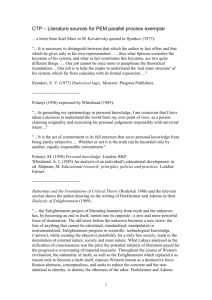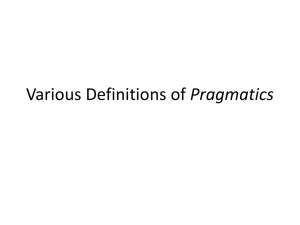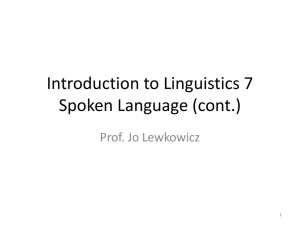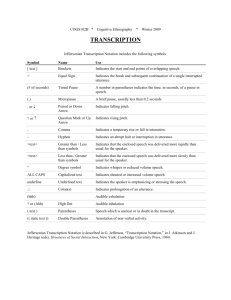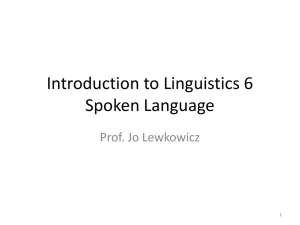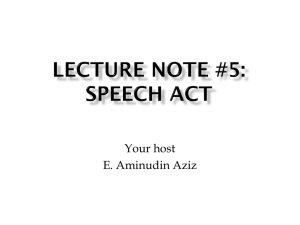Japanese Discourse Markers and the Communication of Emotions
advertisement
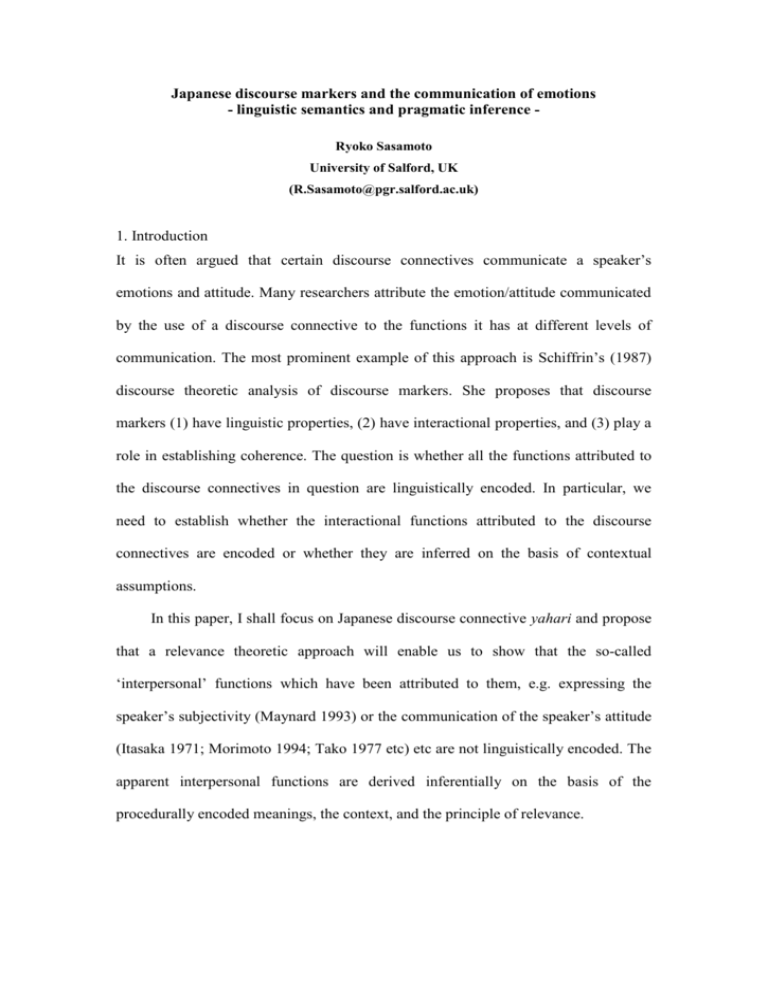
Japanese discourse markers and the communication of emotions - linguistic semantics and pragmatic inference Ryoko Sasamoto University of Salford, UK (R.Sasamoto@pgr.salford.ac.uk) 1. Introduction It is often argued that certain discourse connectives communicate a speaker’s emotions and attitude. Many researchers attribute the emotion/attitude communicated by the use of a discourse connective to the functions it has at different levels of communication. The most prominent example of this approach is Schiffrin’s (1987) discourse theoretic analysis of discourse markers. She proposes that discourse markers (1) have linguistic properties, (2) have interactional properties, and (3) play a role in establishing coherence. The question is whether all the functions attributed to the discourse connectives in question are linguistically encoded. In particular, we need to establish whether the interactional functions attributed to the discourse connectives are encoded or whether they are inferred on the basis of contextual assumptions. In this paper, I shall focus on Japanese discourse connective yahari and propose that a relevance theoretic approach will enable us to show that the so-called ‘interpersonal’ functions which have been attributed to them, e.g. expressing the speaker’s subjectivity (Maynard 1993) or the communication of the speaker’s attitude (Itasaka 1971; Morimoto 1994; Tako 1977 etc) etc are not linguistically encoded. The apparent interpersonal functions are derived inferentially on the basis of the procedurally encoded meanings, the context, and the principle of relevance. 2. Yahari and communication of emotion The Japanese discourse connective yahari is classified as an adverbial by Japanese scholars (e.g. Morimoto 1994 and Takami 1985) and is usually said to communicate that some the utterances that contain them must be interpreted in the light of expectations already held by the speaker1: (1) Iro to katachi, ryouhou o colour and shape, both kanesonaeta mono ga ACC have thing yappari nani mo kaimasen deshita. yahari buy-NEG COP-PAST Thing ACC nakatta GEN no de exist-NEG GEN so ‘One of them was a lovely colour but I didn’t really like the shape. The other one’s colour was weird though I liked the shape. Yappari I didn’t buy either.’ In (1), the use of yahari suggests that the speaker had had an assumption that she might not buy anything. Many researchers argue that in addition to its function as introducing an expectation, the use of yahari could communicate some kind of emotion and/or attitude. For example, some researchers (e.g. Itasaka 1971) claim that the use of the connective communicates that the speaker is being modest, as it refers to some consensus established in the society or culture, which the speaker must follow whether he likes it or not. In other words, since the use of the connective indicates that the speaker has no say in the matter, the speaker appears less pushy. Consider, for example, (2): (2) Shikara-reru kamoshirenai keredo, yappari ne, Scold-PASS Tenka kokka-ron World nation-debate might yori wa than TOP but yappari SF ongaku nanka kiiteru hou ga music etc tanoshii ne. listening more NOM enjoyable SF ‘I might get told off but yappari listening to music is much more fun than having a big discussion about nationalism.’ (Itasaka 1971.217) 1 Japanese glosses are given when each example is first introduced. Here, the use of yahari shows that the speaker’s assertion that listening to music is much more fun than having a big discussion about nationalism is based on a belief which held in society and thus that the speaker is not likely to sound pushy or impolite. The question is whether yahari actually encodes this information. However, in contrast with Itasaka (1971), Tako (1977) argues that the use of connective could give an impression that the speaker is trying to forcing his opinion. This kind of use seems to be illustrated by (3): (3) [In an argument, Mary gave Peter her opinion on the local safety in Salford] Mary: Wakamono wa nanika surukoto ga hituyou desu. Yaritai koto de isogashi Youngster TOP something do-nomz GEN need COP to han-shakaiteki koudou o toru hima wa nai COP anti-social behaviour ACC do want thing with busy hazu. time TOP exist-NEG must ‘We have to provide youngsters with something to do. They wouldn’t behave anti-socially if they are too busy to do their own stuff.’ Peter: Iya, yahari sore wa umaku ikanai to omou. Keisatsu-kan o zouin subeki da. no yahari it TOP well go-NEG COMP think police officer ACC increase should SF ‘No, yahari I don’t think it would work. We just need more police officers.’ The question, then, is why the use of yahari can communicate arrogance in some cases and a non-subjective attitude in others. Although Morimoto (1994) claims to provide a semantic analysis, she also mentions a pragmatic function of yahari. Thus, she claims that the use of yahari in (4) could communicate an attitude of arrogance: (4) P: Nanika nyuusu wa arima-sen deshi-ta ka. any news TOP exist-NEG COP PAST Q ‘Wasn't there any news?’ Q: a. Yahari yahari kokkai ga kaisanshi-mashi-ta. The parlianment NOM split up-HON-PAST ‘Yahari, the parliament has split up.’ b. Yahari genpatsu de jiko ga okori-mashi-ta. at accident NOM occur-HON-PAST yahari nuclear power station ‘Yahari, there was an accident at the nuclear power station.’ c. Yahari hito-ban de yama Yahari one night in mountain ga deki-mashi-ta. NOM form-HON-PAST ‘Yahari a mountain was formed overnight.’ (Morimoto 1994:134) According to Morimoto (1994), the use of yahari in (4c) sounds more awkward and less acceptable than (4a) or (4b). For her, this is because a speaker who uses yahari indicates that the utterance which contains it can be interpreted in the context of an assumption which is mutually known. If this is right, then the use of adverbial where there is no such mutual knowledge gives an impression of arrogance. However, if this utterance is produced in a different context, e.g. if the speaker is known as telling a ridiculous joke, or in a conversation between geologists, it would not communicate an arrogant attitude. Rather, it will be interpreted as ridiculous or just a normal conversation in their laboratory. Once again, the problem lies with the failure to recognise how important it is to find what is really encoded and what is pragmatically inferred. Maynard (1993) analyses the connective in the framework of Discourse Modality (DM). According to Maynard (1993), Discourse Modality is a contextual framework where the propositional content of the utterance is interpreted. The contextual framework is a conceptual (and emotional) space which imposes modal constraint on utterance interpretation and it includes the speaker’s propositional attitude. Maynard (1993) argues that at the semantic level, yahari leads the hearer to make a linkage between the propositional content of the utterance and contextual knowledge. This means that at the discourse modality level, yahari contributes to establishing DM and functions in selecting an appropriate context. The connective, Maynard (1993) argues, contributes to three dimensions of discourse modality; epistemic modality, discourse-organisational modality, and interactional modality. Finally, Maynard (1993) proposes three interactional functions of yahari. First, she argues that as the use of the connective is based on the shared knowledge between speaker and hearer, it invokes rapport. Second, since the use of the connective communicates the personal attitude towards knowledge, the speaker exploits its meaning and uses it as a filler or planner signalling that the speaker is involved in the interaction and is going to produce some utterance. Finally, she proposes that the connective can be used as a hesitation marker particularly when spoken slowly and with hesitancy. Maynard’s (1993) account of yahari does provide some interesting insights. In particular, it seems right to suggest that the semantic function of the connective should be analysed in terms of a relationship between the connective and context. However, her analysis also raises some questions. First, like many other discourse analysts, Maynard (1993) analyses the different ‘functions’ of the connective at different levels of communication. The question is whether all the functions attributed to yahari are linguistically encoded. In particular, we need to establish whether the interactional functions attributed to yahari are encoded or whether they are inferred on the basis of contextual assumptions. Similarly, her analysis does not explain how we would choose one particular interpretation over other possible interpretations. For example, she has proposed four interactional functions of the connective - rapport seeker, hesitation marker, filler, and planner. The question is, how would the hearer choose one over the others? Her descriptive approach raises more fundamental problems; for example, are these four functions exclusive, or is there any other interactional function? Unfortunately, her analysis in terms of DM does not seem to provide answers to these questions. So far, we have seen how the alleged attitude communicated by the use of yahari has been dealt with in past studies. As Kato (1999) points out, various contradicting emotions/attitudes can be communicated by the use of connective. In particular, some researchers claim that the use of the connective conveys a selfless, objective attitude while others claim that the use of connective indicates a subjective attitude. Similarly, while it is often claimed that the use of connective distances the speaker from the assumption the yahari-utterance communicates, others claim that its use communicates the speaker’s personal opinion. In other words, a descriptive and taxonomic approach simply results in a list of emotions the use of yahari can communicate. Such a list does not explain the whole ‘behaviour’ of the connective. To answer these questions, we have to take a cognitively grounded analysis of discourse connectives to figure out what is really encoded by the connective and what is recovered as a result of pragmatic inference. I believe that a relevance theoretic approach to communication will give us means for a successful analysis. In next section, I will look at a relevance theoretic semantics/pragmatics distinction and how it enables us to explain these emotional uses of discourse connectives. 3. A relevance theoretic semantics/pragmatics distinction In a relevance theoretic framework, the distinction between semantics and pragmatics is based on a distinction between decoding and inference – two different processes in utterance interpretation. When an utterance is produced, the hearer recovers semantic representation of the utterance, based on information delivered by grammar, and this process is performed by an autonomous linguistic system. The pragmatic inferential process, on the other hand, integrates the semantic representation with contextual assumptions in order to reach an intended interpretation of the utterance. This inferential phase of interpretation is constrained and guided by the communicative principle of relevance, which licences a hearer to look for an interpretation which interacts fruitfully with his cognitive system to yield cognitive effect which does not put him any unjustifiable processing effort. In other words, when an utterance is produced, the hearer recovers a semantic representation of the utterance based on concept encoded by linguistic forms employed in the utterance. This semantic representation, then, is used as an input to the hearer’s computation system. The input then undergoes pragmatic inference until it reaches the intended interpretation. As it has been argued by Carston (1999), the semantic representation is not fully propositional but is just a template for utterance interpretation which requires pragmatic inference in order to recover the proposition the speaker has intended. (e.g. reference assignment, disambiguation, enrichment/loosening). Thus, in relevance theory, it is assumed that ‘semantics’ is a relation between a linguistic form and the information it provides as input to the inference system, rather than a relation between a linguistic form and an entity in the world. Having established relevance theoretic semantic/pragmatic distinction, I would like to introduce two types of encoding, namely, conceptual and procedural encoding. The relevance theoretic distinction between procedural and conceptual encoding emerged from Blakemore’s (1987) attempts to re-analyse Grice’s notion of conventional implicature, or, from the attempt to provide an explanation for non truth conditional meaning from cognitive point of view. Since discourse connectives such as English so or Japanese demo are problematic for truth conditional analyses, it is not surprising that they have featured in the development of the notion of procedural encoding. Indeed, Blakemore’s approach has been applied to a variety of discourse connectives in various languages. (e.g. Blass 1990; Matsui 2002, and others) Interpreting utterances involves performing inference on conceptual representations. The role of grammar is to derive representations which provide input to inferential phase of utterance interpretation. However, it is not necessarily the case that linguistic semantics provides just one kind of input – given that interpretation involves both computation and representation. It is possible that a linguistic form may encode either information about representations that undergo computation or information about the computation they undergo. The existence of linguistic forms which encode procedures can be justified by principle of relevance, give below: (5) Human cognition tends to be geared to the maximization of relevance. (6) Every act of ostensive communication communicates a presumption of its own optimal relevance. (Sperber & Wilson 1995:260) S&W (1995:270) defines the presumption of relevance as follows: (7) Presumption of optimal relevance (revised) (a) The ostensive stimulus is relevant enough for it to be worth the addressee’s effort to process it. (b) The ostensive stimulus is the most relevant one compatible with the communicator’s abilities and preferences. This means that when an utterance is produced, a hearer can expect to derive an optimally relevant interpretation without having to make any unjustifiable processing effort. The speaker can decrease the amount of processing effort required by using linguistic forms which encode procedures since the use of these expressions instructs the hearer which type of computational path the hearer is expected to follow in order to achieve relevance. Consider (8): (8) David isn’t here. Barbara is in town. (Adapted from Blakemore 1992) In (8), the second segment can either be a conclusion drawn from the first segment or a reason for the state of affairs described in the first segment. The hearer has to decide which interpretation is intended for herself. In contrast, in (9), the use of the discourse connective so instructs the hearer to interpret (b) as a contextual implication derived from (a). (9) (a) David isn’t here. (b) So Barbara’s in town. (Blakemore 1992:150) I would now like to consider the use of yahari in the light of the relevance theoretic distinctions I have just outlined. As we have seen, in relevance theory, linguistically encoded information can contribute to a representation which will then be used as an input to the inference system. In the inference system, this input representation interacts with existing assumptions and the hearer can recover the full meaning of the utterance. As I have argued, there are linguistic forms which encode procedures and guide the hearer to the right (i.e. intended) inference. I wish to propose that yahari encodes procedure and does not contribute to the representation itself. If this is right, we could say that the connective yahari instructs the hearer how to interpret the utterance by guiding her towards the type of assumptions she is expected to use as contextual premises in pragmatic inference. Moreover, since the inferential path which the hearer is expected to take results in the strengthening of certain accessible assumptions, it may appear that yahari may communicate an emotional attitude. 3.1 Yahari and expectation As most past studies agree, both connectives seem to refer to some kind of expectation or assumption behind the utterance. Consider (1): (1) One of them was a lovely colour but I didn’t really like the shape. The other one’s colour was weird though I liked the shape. Yappari I didn’t buy either. Native speakers would intuitively interpret that the use of yahari in (1) indicates the speaker thought he might not buy either of them. It has been argued that the use of the connective introduces some kind of assumption into the context in which the utterance containing the connective is to be interpreted. For example, Nishihara (1988) claims that the role of yahari is to indicate that a certain presupposition is included in the context against which an utterance containing the connective is to be interpreted. Similarly, Tanaka (1993) claims that the use of yahari imposes constraints on the choice of context and directs ‘the hearer to a context which contains an expectation against which the utterance is to be processed, thereby leading to contextual effects intended by the speaker.’ The problem with these studies is that it is not clear what kind of assumptions the use of yahari introduces. When yahari is used, the utterance introduced by the connective expresses an assumption the speaker already holds. The use of the connective instructs the hearer to add (or activate) a (set of) assumption(s) to the context. This means yahari imposes a constraint on the inferential process by specifying the intended contextual effect. In this case, the contextual effect intended to strengthen an existing assumption and the use of yahari triggers an interpretation in which the utterance it introduces is relevant in a context which is consistent with the proposition expressed. In other words, in a form of yahari Q, Q strengthens an existing assumption P which is consistent with the assumption represented in Q. In (1), the use of yahari introduces/strengthens an assumption that the speaker had thought she might not buy any bag, which is compatible with the proposition expressed by the utterance. In other words, the use of yahari instructs the hearer to interpret the utterance in a context which contains an assumption that the speaker might not buy anything. Examples (14) and (15) will show this analysis more clearly: (14) [Mary insists that there are four chocolates are left while Peter insists there are 10 chocolates are left. They got home and Mary checks there are four chocolate is left.] Mary: yappari yottu nokotte iru. Yappari four left exist-PRESENT ‘Yappari there are four chocolates left.’ (15) [Mary insists that there are four chocolates are left while Peter insists there are 10 chocolates are left. They got home and find out there are 10 chocolates left.] Mary: * yappari jukko nokotte iru. Yappari ten left exist-PRESENT *‘Yappari there are ten chocolates left.’ While yahari is acceptable in (14), it is not in (15). As it is obvious from the context, Mary thought there were four chocolates left. In (14), she was right and there are four chocolates left. This means that the utterance introduced by the connective is relevant in a context which is consistent with the proposition expressed (i.e. a context which contains an assumption that there are four chocolates left). In contrast, in (15), although Mary thought there were four chocolates left, there are actually ten chocolates left and she was wrong. In other words, the assumption Mary held contradicts the proposition expressed (i.e. a context which contains the assumption that it is not 10 chocolates which are left). As a result, the use of yahari in (15) is not acceptable. Let us see if we can explain other examples along the same lines: (16) P: Kekka wa doo deshi-ta ka. result TOP how COP-PAST Q ‘How did it go?’ Q: Ik-eru ka na to go-can Q FP COP omt-ta-n-desu ga, think-PAST-EMPH-COP but (a) Dame (a) no good (b) Yahari Yahari dame deshi-ta. cop-past deshi-ta. no good COP-PAST ‘I thought that I might make it, but (a) I couldn't.’ ‘(b) yahari, 1 couldn't.’ (Morimoto 1994:132-133) (17) P: Kekka wa doo deshi-ta ka. Result TOP how COP-PAST Q ‘How did it go?’ Q: Dame ka na to No good Q FP COP omt-ta-n-desu ga, (a) ike think-PAST-EMPH-COP but mashita. (a) go-can ??(b) Yahari Yahari cop-past ike mashita. go-can COP-PAST ‘I thought that didn’t make it, but (a) I did.’ ??’(b) yahari, 1 did.’ In these cases, the first segment of Mary’s utterance explicates the ‘expectation’ she had earlier on. However, the speaker cannot use yahari in (17).2 The use of yahari suggests that the speaker had supposed that she might not have done well (or not as well as she hoped). This is consistent with the proposition expressed in the utterance introduced by the connective. In contrast, in (17), the use of yahari would suggest that Mary had suspected she might have done well, which is consistent with the proposition expressed in the utterance introduced by the connective. However, as Mary has already said that she had thought she did not do well, it becomes awkward to use yahari in the following utterance. So far, we have established that yahari encodes a procedure and instructs the hearer to add an assumption to the context in which the utterance which contains the connective is to be interpreted. Now, let us see how we could provide a unitary account for the interpersonal (or emotional) functions of the connective in the light of the relevance theoretic distinction between linguistic encoding and pragmatic inference. The advantage of a relevance theoretic approach is that we can explain the socalled ‘interpersonal’ function; for it suggests that the connectives do not encode interpersonal information, such as the expression of subjectivity (Maynard 1993) or the communication of the speaker’s attitude (Itasaka 1971; Morimoto 1994; Tako 2 Or, at least it is very strange to use yahari in (17) 1977 etc) etc. The apparent interpersonal functions are derived inferentially on the basis of the procedurally encoded meanings, the context, and the principle of relevance. It simply depends on where the assumption comes from. For example, if P is a set of assumptions which represents a social custom, it might appear that the speaker is attributing the thought to the society. Or, if P is a set of assumptions which represents an assumption mutually manifest to the speaker and hearer, it might appear that the speaker is attributing the thought to ‘common sense’. According to Sperber & Wilson (1986/1996:230), verbal communication involves ‘a speaker producing an utterance as a public interpretation of one of her thoughts, and the hearer constructing a mental interpretation of this utterance, and hence of the original thought.’ And the speaker’s thought, or, a mental representation is either an interpretation of description of the world or of some attributed thought. Thus, in the framework of relevance theory, it is not surprising that we can shift the responsibility from the speaker to the society. If the utterance in question is an interpretation of socially accepted convention, the hearer would be able to understand that the utterance is an interpretation of the attributed thought and hence the thought would not be attributed to the speaker. The propositions which are used to represent attributed thoughts may be interpretations/representations of a thought attributed to a particular individual or of a thought attributed to a particular group. In the latter case, we might say that the proposition expressed is an interpretation of a socially accepted convention. As S&W show, utterances which are used attributively do not come with a guarantee of truthfulness but with a guarantee of faithfulness; an utterance which expresses a proposition which is an interpretation of an attributed thought gives rise to the expectation that the proposition resembles the thought represented. Since the speaker of such an utterance is not providing a guarantee of truthfulness, we might say that she is shifting the responsibility for the thought to others. Let us see if we could explain the emotion discussed in past studies could be explained by this: (2) I might get told off but yappari listening to music is much more fun than having a big discussion about nationalism. (Itasaka 1971.217) In a context in which it is assumed that discussing politics is boring, listening to music would be much more fun. In other words, the speaker produces this utterance as an interpretation of thought which is attributed to the audience and thus he could sound less pushy or arrogant. As we have seen, in (3), the use of yahari could communicate arrogance: (3) [In an argument, Mary gave Peter her opinion on the local safety in Salford] Mary: We have to provide youngsters with something to do. They wouldn’t behave anti-socially if they are too busy to do their own stuff. Peter: No, yahari I don’t think it would work. We just need more police officers. The use of yahari in (3) could communicate arrogance because the assumption yahari introduces here is not attributed to the society or anyone else. This is the speaker’s thought. Thus, this could sound arrogant. Next, Morimoto (1994) says the use of yahari in (4) could communicate arrogance too: (4) P: Is there any news? Q: Yahari a mountain was formed overnight. According to Morimoto (1994), the use of yahari in (4) sounds awkward and it could give an arrogant impression. For her, this is because a speaker who uses yahari indicates that the utterance which contains it can be interpreted in the context of an assumption which is mutually known. If this is right, then the use of adverbial where there is no such mutual knowledge gives an impression of arrogance. However, if this utterance is produced in a different context, e.g. if the speaker is known as telling a ridiculous joke, it would not communicate an arrogant attitude. Rather, it will be interpreted as ridiculous. And the only way this utterance could communicate arrogance is that everyone else is surprised while the speaker produces this utterance as a matter of course. In that case, the use of yahari suggests that she had expected the news although the news undoubtedly would come as a shock for everyone else. Thus, the utterance would be taken as communicating I know the best kind of attitude and thus becomes arrogant. In this paper, I have shown that the emotions/attitudes which have been attributed to a Japanese discourse marker can be derived from the constraints on interpretation which each discourse marker encode, together with the assumptions about the particular context in which they are used. The consequence of this analysis is that cognitively grounded linguistic semantics can provide a basis for the analysis of a pragmatically inferred meaning and thus we do not need to say that these expressions are ambiguous between an ‘emotional’ interpretation and a ‘normal’ interpretation. Abbreviations: ACC, accusative; COP, copular predication; COUNT, counter; DAT, dative; HEAR, hearsay particle; LOC, locative; NEG, negation; NOM, nominative; NOMZ, nominalizer; Q, question marker; QUO, quotative; SF, sentence-final particle; TOP, topic marker. References Blakemore, D. (1987). Semantic Constraints on Relevance. Oxford: Blackwell. . (1992) Understanding Utterances. Oxford: Blackwell. Blass, R. (1990). Relevance Relations in Discourse. Cambridge: Cambridge University Press. Carston, R. (1999). "The semantics/pragmatics distinction: A view from relevance theory." In: The Semantics/Pragmatics Interface from Different Points of View. Ed. K. Turner. Amsterdam: Elsevier, 85-125. Itasaka, G. (1971). Nihonjin no ronri kouzou. Tokyo: Kodansha. Kato, K. (1999) ‘Yahari-ron no mondaiten’ [Problems with yahari] in Nihongo Kenkyu to Nihongo Kyoiku. Tokyo: Maiji Syoin. 165-183. Morimoto, J. (1994). Hanashite no shukan wo arawasu fukushi nit suite. Tokyo: Kuroshio. Matsui, T. (2002). Semantics and pragmatics of a Japanese discourse marker dakara (so/in other words): a unitary account. Journal of Pragmatics 24:867-891. Maynard, S. K. (1993). Discourse Modality: Subjectivity, Emotion, and Voice in the Japanese Language. Amsterdam: John Benjamins. Nishihara, R. (1988). ‘Washa no Zentei: Yahari (yappari) no Baai’ [A Speaker’s Presupposition in case of Yahari (yappari)]. Nihongogaku. 7:89-99 Schiffrin, D. (1987). Discourse Markers. Cambridge: CUP. Sperber, D. and D. Wilson (1986/1995). Relevance: Communication and Cognition. Oxford: Blackwell. Takami, K. (1985). ‘Nichiei go no bun-shouou to fukushi/fukushiku.’ [Sentential Anaphora and Adverbs/Adverbials in Japanese and English] Gengo Kenkyu 87.68-94. Tako, T. (1977). Sinsou Sinrijutsu. Tokyo: Goma Shobo. Tanaka, K. (1988). ‘The Japanese Adverbial yahari or yappari’ in Carston, R. & S. Uccida (edd). Relevance theory: Applications and Implications. Amsterdam: John Benjamins. 23-46


